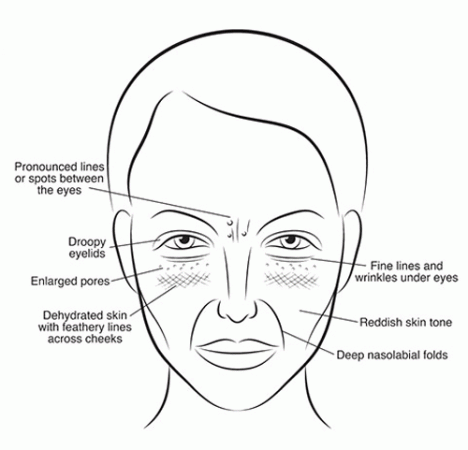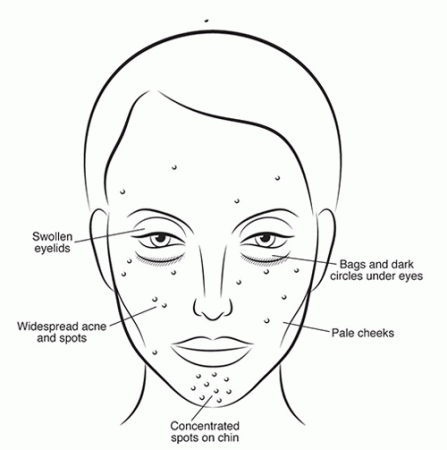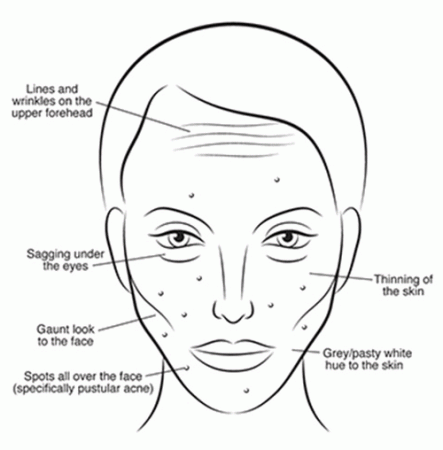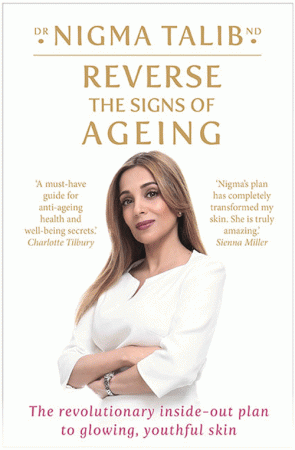We’ve talked a lot about gut health in SPA+CLINIC over the past 12 months; about how it’s fundamental to our wellness and wellbeing – and how healthy/good we look.
“Beauty begins in the belly,” is the mantra of The Beauty Chef‘s founder Carla Oates, for instance.
Now London-based naturopathic expert Dr Nigma Taleb has narrowed it down even further, to how specific substances can literally shape our faces – for the way worse.
In her new book Reverse the Signs of Ageing, Dr Nigma has identified how four common food (or drink, as the case may be) groups – dairy, wine, sugar and gluten – significantly contribute to common skin problems such as breakouts, puffy eyes, pigmentation, dehydration (hence formation or worsening of lines and wrinkles) and redness.
She explains her theory of “eating for beauty”, and encourages people (and you on your clients’ behalf) to find out which “face” most accurately represents individual skin concerns and then cutting down on the food that’s causing the problems.
Dr Nigma’s London practice client list reads like a Golden Globes red carpet roll call: Emilia Fox, Jamie Dornan, Jeremy Piven, Sienna Miller.

In fact, it was at this year’s Golden Globes, she says, that Penelope Cruz (left) noticed a change in Sienna Miller’s (below left) skin and asked what she was doing.
“I had been seeing Sienna for two years and she was always saying to me: ‘I’m going to blab about you to everyone’,” says Dr Nigma.
 “So when Penelope asked her secret, Sienna replied: ‘Go see Dr Nigma!’ And she’s been my client ever since’.”
“So when Penelope asked her secret, Sienna replied: ‘Go see Dr Nigma!’ And she’s been my client ever since’.”
Penelope now attests: “Nigma’s plan will change your life”.
Dr Nigma has created facial charts specific to each substance after seeing the same patterns in thousands of patients in pursuit of helping people achieve optimally healthy, and even flawless skin. So let’s get to the nuts and bolts of Dr Nigma’s philosophy …

Ageing characteristics can be triggered by any kind of alcohol, which dehydrates the skin, worsening the look of fine lines and wrinkles. The high sugar content also damages the protein collagen – vital for keeping skin elastic – causing enlarged pores and droopy eyelids.
The space between the eyes is associated with the liver, so wine face sufferers tend to have deep lines or redness between the brows.
Alcohol also slows down the enzyme that the body uses to fight inflammation, resulting in flushed cheeks and a red nose.
Treatment: Dr Nigma recommends taking a three week alcohol break then sticking to the 80/20 rule. Abstain for 80 per cent of the time, and you can enjoy small quantities for the other 20 per cent.
If you want to drink, opt for gluten-free spirits such as rum, tequila or potato-based vodka. And if you want a glass of wine, try red instead of white or choose ones with a lower sugar content, such as sauvignon blanc, pinot grigio, merlot or pinot noir.

The protein found in wheat, barley and rye has been shown to increase the inflammatory response, leaving the face looking bloated, inflamed or swollen.
Gluten can also affect the pigmentation of the skin, leading to age spots and darker patches on the chin.
If you develop an itchy blistery rash after consuming gluten this could also be a symptom of coeliac disease – a digestive condition where a person has an adverse reaction to gluten. If you suffer from these symptoms you should tell your doctor.
Treatment: No matter how many supplements you take or how many peels you have, nothing will make your skin look better than just removing gluten from your diet, says Dr Nigma. Combine this with drinking more water and consuming more fibre.

As we age we lose the enzymes that allow us to digest lactose effectively, which can cause the immune system to trigger the release of inflammatory chemicals.
This can cause redness and swelling, as well as puffy eyelids, under-eye bags and dark circles on the face.
Milk also contains chemicals that can disrupt the balance of hormones, which cause an over-growth of skin cells, blocking pores and trapping bacteria. This results in breakouts that tend to happen on the chin.
Treatment: Cut out all dairy products for three weeks and try taking primrose oil in the evenings, as it is a powerful anti-inflammatory. Eating foods rich in vitamin A, such as eggs, liver and carrots, as well as vitamin E, found in nuts and leafy vegetables, can also help to repair the gut.

Too much sugar can cause the springy, elastic collagen fibres in skin to become rigid and inflexible (a process known as glycation that accelerates skin ageing).
As well as saggy skin, sugar increases the levels of insulin, making the face appear washed-out and sallow.
Sugar also affects the balance of bacteria in the gut, which can lead to breakouts on the face, shoulders and chest. But most peculiarly, it can also affect the eyebrows. Insulin imbalance can leave eyebrow hair looking wispy and fine.
Treatment: Sugar is in virtually every meal we consume, so cutting out additional sugar entirely, such as in cakes, fruit juices and processed food, will have an amazing effect on the skin. Even just cutting your sugar intake in half will help improve your complexion. For the best results, Dr Nigma recommends cutting out whatever food substance is irritating the skin for 28 days, before carrying on with the 80/20 rule for two months afterwards.
For the best results, Dr Nigma recommends cutting out whatever food substance is irritating the skin for 28 days, before carrying on with the 80/20 rule for two months afterwards.
Most people will begin to see visible differences within two weeks, but she warns not to get disheartened if the results are not immediate, as some people have more stubborn skin than others.
And while there’s no such thing as a quick fix in the world of beauty, there are a couple of ways you can improve your skin within a couple of days.
Cutting out dairy, gluten, sugar and alcohol entirely before an event, Dr Nigma says, can help reduce bloating; and dabbing on frozen cucumber, aloe vera and turmeric in a face washer can help reduce irritation in the face.
Now get glowing!




